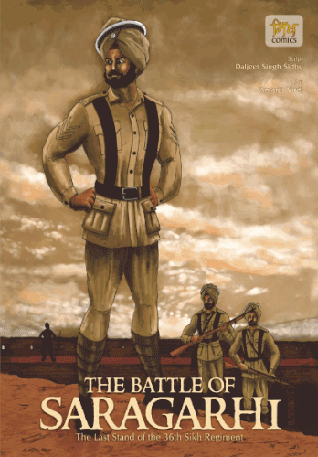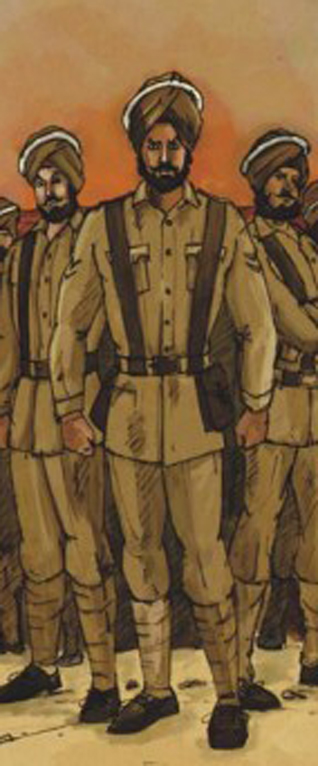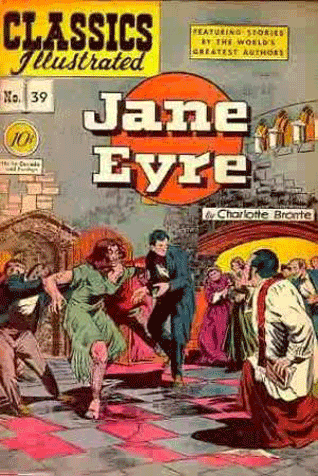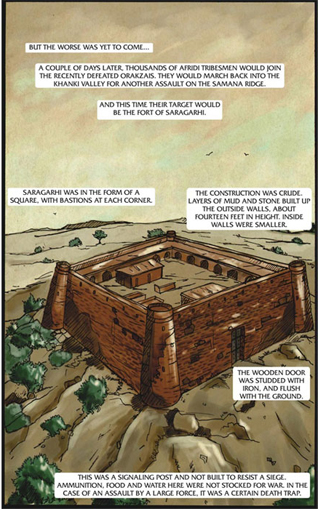Books
Sikh Comic Books:
The Battle of Saragarhi
T. SHER SINGH
DAILY FIX
Saturday, June 2, 2012
The book reviewed herein is sikhchic.com's BOOK OF THE MONTH for June, 2012.
THE BATTLE OF SARAGARHI: THE LAST STAND OF THE 36TH SIKH REGIMENT, by Daljeet Singh Sidhu (Script Writer), Amarjit Virdi (Art Director), Rochak Bhatnagar & Amit Gautam (Artists). Sikh Comics, Punjab, 2012. Paperback, colour, English, illustrated, pp 40. ISBN: 978-81-909637-4-9.
Comic books first became part of my life in the form of contraband.
It’s because they had a double whammy against them: they were banned both at home and at school. Which automatically made them desirable, a must-have-at-all-costs.
Conventional wisdom inherited by my parents said that the young should be kept clear of three evils: addiction, gambling and novels!
‘Addiction’ included liquor, ganja and afeem.
‘Gambling’ came to include the stock-market and the sattaa bazaar.
But why ‘novels’? Because, it was believed, reading them was distracting, they led to a total waste of time, and, who knows, even taught you anti-social behaviour. Such as love and romance, I would guess.
When comics appeared on the scene, they were thrown into the same category.
At school, comics didn’t fare any better.
Teachers merely regurgitated what had been handed down to them by the system: that comic books were detrimental to a child’s educational health. They taught you poor language skills through colloquialisms, put disproportionate emphasis on illustrations and not enough on text, and discouraged you from reading real books.
All of this resulted in a strict ban of comic books on the school premises, and clear instructions to parents to not allow them at home.
Which meant each of us in boarding school had a secret stash of comics and there was an unending traffic in them through barter and exchange, loans and even theft, always out-of-sight of teachers and hostel staff.
Which in turn made them primary currency. Sharing the mitthaa-ee goodies from my weekly red-cross parcel, for example, yielded considerable generosity from my dormitory mates in their willingness to part with their favourite comic books, albeit only for a day or two.
Needless to say, there were inadvertent slip-ups and vicious betrayals … leading to a walloping taste of the cane or the leather strap.
Grade Seven, however, brought a life-transforming change in our lives, at least for the 18 or so in our class.
Our new teacher, freshly off the boat - Brother Michael Johnson - laid out his personal educational strategy to us on the very first morning.
He threw out the notion, hitherto liberally imposed on us, that we should read the newspaper everyday, preferably The Statesman from Calcutta, “because its English is impeccably flawless!” Or the TIME magazine, a copy or two of which was to be found amongst the seniors.
“You’re not going to learn much if you have to force yourself to get into it each time, and if it bores you to death.”
And then, he laid out his method: “I want you to read junk. Anything and everything you want to read, as long as you enjoy reading it! So read and read, not to learn, but to enjoy.”
“Comics?” someone asked mischievously.
“Yes, of course!” he replied with no hesitation whatsoever. “Why not?”
Our class was given special dispensation. We could henceforth read comics … and Perry Mason too!
Dell comics were the rage then. In a world - ours! - in which television had not even been heard of, I was quickly introduced to Mickey Mouse and Mighty Mouse, Speedy Gonzales and Yosemite Sam. Gene Autry, Roy Rogers and Rin Tin Tin.
And then followed a whole new universe … of Classics Illustrated!
These were adaptations of literary classics of the world’s most famous books - and we devoured them hungrily until we became intimately familiar with authors and books that we had hitherto heard mentioned only in reverence and awe.
Once you read the comic book version of “Jane Eyre”, the natural next step - it needed no nudging or goading - was seeking out the book itself and consuming it.
But for that door that Brother Johnson had opened for us that day, I often wonder what my life would’ve been like; certainly not one populated with words which gave a bounce to one’s feelings and stretched one’s thoughts.
Mercifully, children today have been freed from the earlier strictures. In fact, when my daughter was of age, I gleefully introduced her to comic books, and I know parents who do this everywhere.
Therefore, it is such a relief that Sikh activists too have discovered the merit of building a whole library of Sikh comics whereby children can be introduced to our history and literature, our tales and sagas, and thereby create a hunger for more.
Through the years, many artists, educationists and publishers have entered the field, some of them with delightful results.
The work done by Sikh Comics stands out, head and shoulders, over most of them.
With a number of publications already under their belt, including a series on Guru Nanak, and one each on Guru Tegh Bahadar and Baba Deep Singh, their latest venture turns to a relatively modern era: the saga of The Battle of Saragarhi.
Subtitled “The Last Stand of the 36th Sikh Regiment”, it tells the story of 21 soldiers who, fighting against super-human odds, finally fell to the last man defending their fort … and entered September 12, 1897 into the annals of human history as one of its finest chapters.
This comic book is designed to appeal to the young and adults alike, and is easily successful in doing it.
The illustrations are pleasing to the eye and never deteriorate into caricature. The colours are muted, capturing the correct atmosphere and ambience of the tale.
The story too is well told, starting with laying out the context and the scene. And then gradually picking up pace, building the suspense and the terror, and then racing us to the tragic climax and conclusion.
Both the dialogue and the narration are clear, though I wonder if younger children would benefit from a simpler vocabulary.
Also … and this is not meant to be fault-finding or a criticism … a greater reliance on dialogue by letting the story unravel more through the interchange between the characters and less by narration, would make it all the more dramatic and exciting to the younger reader.
It reminds me of the Classics Illustrated that was the staple I grew up on and I must say that Saragarhi compares favourably. That is no small achievement, considering that the Classics went on to publish 169 different publications over the course of three decades.
The two - though separated by half-a-century, the overall subject matter and the target audience - have immense similarities, especially in style and approach.
The Classics are time-tested, having withstood the changing tastes of several generations - they are still around, believe it or not, in various manifestations!
If anything, Sikh Comics has the advantage of new technology and more efficient tools. And they have employed them to advantage.
I wish this series had been around when I was growing up. It would have accelerated my introduction to Sikh history and whetted my appetite early enough to have pursued my interests in a more organized and structured manner, instead of the haphazard and meandering route I had to take in my journey.
One more suggestion: while Sikh Comics has indeed made its mark in terms of quality, it needs to also concentrate on quantity.
For comic books to become a useful tool for our children, a dozen or so titles will do little more than serve as birthday and gurpurab presents, and provide sporadic entertainment.
Somehow, by hook or by crook, Sikh Comics needs to finagle a way of producing these titles faster, say a dozen every year, making it one new title every month.
Subscriptions for monthly mailings will, I’m confident, come to the fore and help support the expanded venture financially. I fall back on my own experience with the Hindi monthly, Chandamama, and the memory of how effective it was in filling me up with huge doses of the subcontinents’s mythology.
I reiterate: it is fundamentally important that we as a community aim to help create a body of at least 100 comic titles by the end of this decade, if not sooner.
It will bring rich dividends.
But now, for today, I cannot recommend strongly enough, that each of us go online and purchase 10 copies each of The Battle of Saragarhi and gift them to our children, our nephews and nieces, and the children of our friends, colleagues and neighbours.
It costs virtually nothing - Rs. 75 or $3.99 per copy.
The support will go a long, long way.
The free bonus is, of course, an extraordinary story, brilliantly told!
You can visit SIKH COMICS by CLICKING HERE






